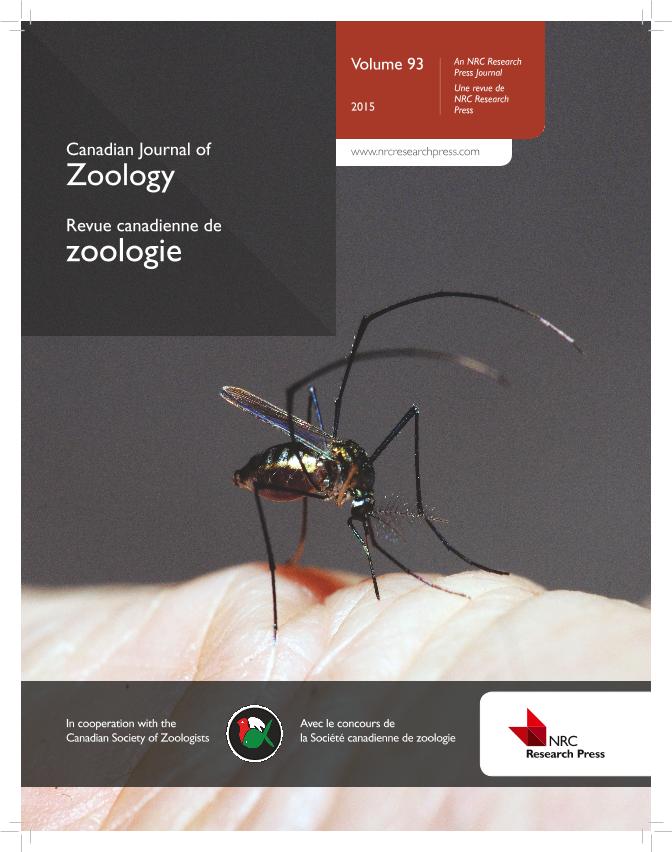Artículo
The maturation of mammalian carnivores from a lactating juvenile to a predatory adult requires a suite of changes in both morphology and behaviour. Bobcats (Lynx rufus (Schreber, 1777)) are medium-sized cats with well-developed skulls to process large prey that can exceed their body mass. An integrated view of the skull ontogeny in the bobcat was developed to detect the relationship between shape, size (on the basis of three-dimensional geometric morphometric analysis), and life history. Dietary changes from juvenile to adults were taken into account and compared with other carnivores. Newborns were different from the remaining age stages in the behavioral and morphological characters examined, which allows us to relate them to the terminal morphology reached during the prenatal period. All findings were related to the reinforcement of the skull and the enhancement of predatory skills in adult bobcats. The final cranial shape is reached in A2 age class, after 2 years of age, and once sexual maturity has been reached. This is a pattern not followed for the rest of carnivores previously studied, which might be related to the capacity of subduing prey that exceed them in size, a behavior not common in felids of the body size of bobcats. La maturation des mammifères carnivores du stade de juvénile allaité à celui d’adulte prédateur nécessite une série de changements tant morphologiques que comportementaux. Les lynx roux (Lynx rufus (Schreber, 1777)) sont des félins de taille moyenne dotés de crânes bien développés leur permettant de chasser et consommer des proies de masse plus grande que la leur. Une vue intégrée de l’ontogénie du crâne du lynx roux a été élaborée afin de déceler les liens entre la forme, la taille (sur la base d’une analyse morphométrique géométrique tridimensionnelle) et le cycle biologique. Les modifications de l’alimentation du stade de juvénile a` celui d’adulte ont été prises en considération et comparées a` celles d’autres carnivores. Les nouveau-nés étaient différents des autres groupes d’âge en ce qui a trait aux caractères comportementaux et morphologiques examinés, ce qui nous permet de les relier a` la morphologie terminale atteinte durant la période prénatale. Toutes les constatations étaient reliées au renforcement du crâne et a` l’amélioration des habilités de prédation chez les lynx roux adultes. La forme crânienne finale est atteinte dans la classe d’âge A2, après 2 ans et une fois la maturité sexuelle atteinte. Il s’agit d’une évolution non observée chez les autres carnivores déja` étudiés, qui pourrait être reliée a` la capacité d’avoir le meilleur sur des proies de taille supérieure, un comportement peu répandu chez les félidés de la taille du lynx roux.
A three-dimensional skull ontogeny in the bobcat (Lynx rufus) (Carnivora: Felidae): a comparison with other carnivores
Fecha de publicación:
01/2015
Editorial:
Natl Research Council Canada-n R C Research Press
Revista:
Canadian Journal Of Zoology
ISSN:
0008-4301
e-ISSN:
1480-3283
Idioma:
Inglés
Tipo de recurso:
Artículo publicado
Clasificación temática:
Resumen
Palabras clave:
Bobcats
,
Lynx Rufus
,
Development
,
Felids
,
Growth
,
Geometric Morphometrics
Archivos asociados
Licencia
Identificadores
Colecciones
Articulos(CCT - NOA SUR)
Articulos de CTRO.CIENTIFICO TECNOL.CONICET - NOA SUR
Articulos de CTRO.CIENTIFICO TECNOL.CONICET - NOA SUR
Citación
Segura Gago, Alda Valentina; A three-dimensional skull ontogeny in the bobcat (Lynx rufus) (Carnivora: Felidae): a comparison with other carnivores; Natl Research Council Canada-n R C Research Press; Canadian Journal Of Zoology; 93; 3; 1-2015; 225-237
Compartir
Altmétricas




